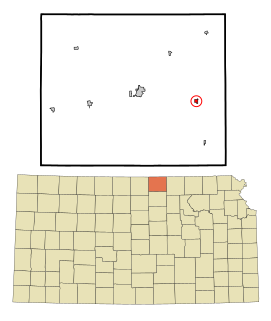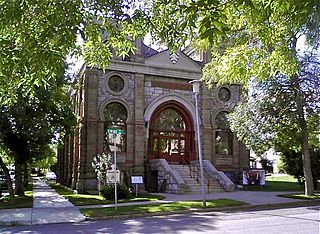 W
WThe Nationality Rooms are a collection of 31 classrooms in the University of Pittsburgh's Cathedral of Learning depicting and donated by the national and ethnic groups that helped build the city of Pittsburgh. The rooms are designated as a Pittsburgh History and Landmarks Foundation historical landmark and are located on the 1st and 3rd floors of the Cathedral of Learning, itself a national historic landmark, on the University of Pittsburgh's main campus in the Oakland neighborhood of Pittsburgh, Pennsylvania, United States. Although of museum caliber, 29 of the 31 rooms are regularly used as functional classrooms that are utilized daily by University of Pittsburgh faculty and students, while the other two are mostly used as display rooms viewed through glass doors and are otherwise utilized primarily for special events and can only be explored via special guided tour. The Nationality Rooms also serve in a vigorous program of intercultural involvement and exchange in which the original organizing committees for the individual rooms remain as participants and includes a program of annual student scholarship to facilitate study abroad. In addition, the Nationality Rooms inspire lectures, seminars, concerts exhibitions, and social events which focus on the various heritages and traditions of the nations represented. The various national, traditional, and religious holidays of the nations represented are celebrated on campus and the rooms are appropriately decorated to reflect these occasions. The Nationality Rooms are available daily for public tours as long as the particular room is not being used for a class or other university function.
 W
WJohann Martin Boltzius was a German-born American Lutheran minister. He is most known for his association with the Salzburger emigrants, a group of German-speaking Protestant refugees who migrated to the British colony of Georgia in 1734. They founded the city of Ebenezer, Georgia to escape persecution in the Archbishopric of Salzburg and other Roman Catholic authorities for their religious views.
 W
WThe Church of Saint Agnes is an onion-domed church building designed by George Ries, built 1901–1912 for the German-speaking Austro-Hungarian population of immigrants in Saint Paul, Minnesota, United States. It is listed on the National Register of Historic Places.
 W
WCuba is a city in Republic County, Kansas, United States. As of the 2010 census, the city population was 156.
 W
WEbenezer, also known as New Ebenezer, is a ghost town in Effingham County, Georgia, United States, along the banks of Ebenezer Creek. It was listed on the U.S. National Register of Historic Places as Ebenezer Townsite and Jerusalem Lutheran Church in 1974.
 W
WTemple Emanu-El in Helena, Montana, United States, was the first Jewish synagogue to be constructed between St. Paul, Minnesota, and Portland, Oregon. It was completed in 1891. The once-thriving Jewish community of Helena declined to the point that by the 1930s they could no longer maintain the building, and it was sold to the State of Montana, which added a second floor, converted it to office space and removed most religious symbolism from the building, though kept the unique stained glass windows. Eventually, the building fell into disuse by the state other than storage space, and so it was purchased by the Catholic Diocese of Helena, which owns it today and uses it to house their administrative offices. While the Jewish communities of Montana have always been small, they have become more active and visible in recent decades.
 W
WGerman Life is a current bi-monthly magazine written for all people interested in the diversity of German, Austrian, and Swiss culture yesterday and today, and in the various ways that North America has been shaped by its German heritage element. The magazine is dedicated to solid reporting on cultural, historical, social, and political events.
 W
WMacksburg Lutheran Church is a historic Lutheran church located in Canby, Oregon, United States. The church was built between 1892 and 1894, in order to serve the needs of German-speaking immigrants from Germany and Austria. Historically, the church offered sermons and Sunday school in both the German and English languages, on an alternating basis.
 W
WThe Louis Marchetti House is located in Wausau, Wisconsin, United States. It was added to the National Register of Historic Places in 1996.
 W
WLeopold Charles Matzal was a 20th-century Austrian-American visual artist. He was a realistic painter, known in New York City and northern New Jersey for his society portraiture and also, later in his career, for murals.
 W
WThe Neue Galerie New York is a museum of early twentieth-century German and Austrian art and design located in the William Starr Miller House at 86th Street and Fifth Avenue in New York City. Established in 2001, it is one of the most recent additions to New York City's famed Museum Mile, which runs from 83rd to 105th streets on Fifth Avenue in the Upper East Side of Manhattan.
 W
WThe Gustav Rohrich Sod House was a sod house located in Bellwood, Nebraska, United States. It was built in 1883 on 80 acres (32 ha) of land by Gustav Rohrich (1849–1938), an immigrant from Austria, for himself, his wife and three children. Its walls are made of sod laid in blocks, grass side down, with each block approximately 2 to 2.5 feet (0.76 m) long, 12 to 16 inches (410 mm) wide, and 3 to 4 inches (100 mm) deep.
 W
WThe Rosencrans Cabin is part of a small historic district comprising five log buildings on three acres in Bridger-Teton National Forest, just east of Grand Teton National Park. The cabin was used by Rudolph "Rosie" Rosencrans, who played a role in the development of Teton National Forest and who later became a U.S. Forest Service administrator in the early 20th century. Rosencrans was buried at this location.
 W
WSt. Paulus Evangelisch Lutherischen Gemeinde is a historic Lutheran church in Jonesboro, Illinois. The church was built by immigrants from Austria, who settled in the Jonesboro area in 1852. Architect Charles Fettinger, one of the settlers, designed the church. The wood frame church features a limestone foundation, upper-story windows topped by lunettes, and a double entrance topped by an arched transom. The interior of the church features an intricately carved wooden altar and pulpit, also designed by Fettinger. Construction on the church was completed in 1860, and the building was dedicated in 1861. The church's bell tower, which is topped by a spire, was added in 1889. The Queen Anne style parsonage was constructed in the 1900s. Services at the church ended in 1949, and the church became the property of the Kornthal Congregation and Historical Society. It was refurbished in 1963 with the aid of the State of Illinois. The church is one of the only remnants of southern Illinois' German-speaking population.
 W
WThe Salzburger Emigrants were a group of German-speaking Protestant refugees from the Catholic Archbishopric of Salzburg that immigrated to the Georgia Colony in 1734 to escape religious persecution. This group was expelled from their homeland by Count Leopold Anton von Firmian (1679–1744), Prince-Archbishop of Salzburg. On October 31, 1731, he issued an Edict of Expulsion demanding from the Salzburg Protestants to recant their faith. Pastor Samuel Urlsperger, the leader of the Society for Promotion of Christian Knowledge, called upon King George II of England for help. The Lutheran King offered them refuge in his Georgia colony, which later became the town of Ebenezer.
 W
WWaterville is a town in Pepin County, Wisconsin, United States. The population was 859 at the 2000 census. The unincorporated community of Arkansaw is located within the eastern portion of the town.
 W
WZion Lutheran Church, also known as the Zion Church of the City of Baltimore, is a historic Evangelical Lutheran church located in downtown Baltimore, Maryland, United States, founded 1755.